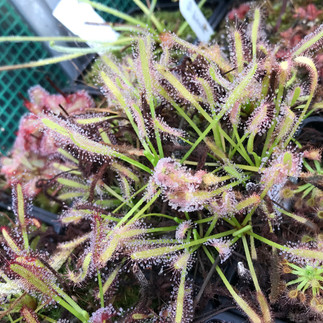How To Care for Sub-Tropical Drosera
- Megan
- Jan 25, 2023
- 5 min read
Updated: Mar 9, 2023
Sundews are by far my favourite carnivorous plant genus, with pygmy sundews and Drosera regia being amongst my favourite plants, sub-tropical sundews therefore have to be my favourite types of sundew!
Drosera are the sparkling jewels of the carnivorous plant world, with leaves covered in mucilaginous glands which produces a sticky substance which binds insects to their leaves. They capture an abundance of prey from small fruit flies to large bluebottles. Due to the diversity between species amongst the genus, these plants comes in a range of sizes and leaf shapes!
All species of sundews have tentacles which respond to contact with their prey, as the prey struggles the more sticky substance is produced and then releases digestive enzymes to break down the soft parts of the insect before absorbing it through the leaf in order to use for nutritional gain. Not all species will completely wrap their leaves around prey, some have very little movement and some roll up rather dramatically like Drosera regia!
Sub-tropical and even tropical species of Drosera include a large variety of easy to grow species such as Drosera capensis which in most collections is considered a weed due to its ability to reproduce so readily from seed.
Lighting:
Almost all sundews will be happy in a sunny to partially sunny positions, they do not do well in shade. In order to achieve the best colour and growth, sundews should be placed in a bright sunny position with as much light possible.
A selection of my sundews in my unheated greenhouse which receives sunlight from sunrise to sunset
Watering:
Use the tray method and keep your sundews sitting in a tray of water throughout the growing season, do not let them ever dry out and make sure to use distilled, reverse osmosis or rain water only. For Drosera regia, different watering may be required as this species does not like warm roots and therefore top watering with cool water in summer is often a preferred method by some growers.

A tray of some of my sundews sitting in water through the growing season
Media:
Many species will do well in peat and perlite/ sand mix in a ratio of 3:1. Drosera regia and pygmy sundews prefer a more looser mix, therefore more sand/perlite is used with less peat. (I will create separate blog posts for both pygmy sundews and Drosera regia in order to cover more specific requirements)
When repotting you can use pots with drainage holes from 7-10cm in size. Undrained containers and tanks can also be used but monitor watering to avoid rot. Larger plants, such as Drosera regia, can be repotted into larger and deeper pots.
Dormancy:
Sub-tropical and tropical sundews do not require a dormancy and will grow year round. However in the winter months when there is less light, you may find your sundews will have less dew and smaller growth.

Positions:
Windowsills:
Many species do perfectly on a bright sunny windowsill. Drosera capensis (cape sundew), Drosera aliciae (Alice sundew) and Drosera spatulata (spoon leaved sundew) for example are great candidates for sunny windowsills.
Terrariums:
Due to their light requirements many easy to keep species are able to be kept in terrariums especially if under lights which will bring out the colour of the plants. Be careful not to cook your sundews if you are placing a terrarium on a hot and sunny windowsill.
Greenhouses:
Due to the cold winters and no need for dormancy you do not need to grow your sundews in a greenhouse environment. Yet, they do well in frost free greenhouses and can often tolerate lower temperatures.
However there are also many sub-tropical species which can tolerate the frost and come back the following year from the roots. I keep all my sub-tropical collection in my unheated greenhouse and rarely bring any in for winter, most come back from the roots, propagate readily or form a bud similar to a hibernacula in order to withstand the winter cold.
Drosera capensis and similar easy to care for sub-tropical sundews will die back completely in an unheated greenhouse, looking like the plant is completely dead however they will sprout new plants from the roots when the weather warms up. Drosera regia can form a hibernacula like form to tolerate the cold and then unfurls in Spring. And pygmy sundews will either propagate from gemmae produced at the end of each year or I find if they are kept well ventilated and not boggy the parent plants will keep for a few years even during the winter.
Left to right: Drosera capensis 'alba' starting to die back, Drosera capensis coming back in Spring from the roots, Drosera capensis and Drosera capensis 'alba' coming back from old growth in Spring.
Left to right: Drosera capensis completely frozen outside, plant will die completely but come back in Spring, Drosera regia hibernaculum in winter, Drosera x carbarup with a tower of gemmae.
If you want to find out how to grow pygmy sundews from gemmae click here
Feeding:
They will happily take gnats, flies, ants and larger species will eat spiders, moths and similar. Most will capture prey in abundance during the growing season, even when kept indoors but you can also feed live prey or dried insects onto their leaves. Be careful not to overfeed or put too large of prey onto the leaves as this can cause leaf burn.
A selection of my plants and the prey they have captured!
Flowers:
Most sundews have self-fertile flowers meaning they do not require pollination in order to produce seed (except some species of pygmy sundews which require pollination), some species especially can produce thousands of seeds from one flower stalk and they also have the ability to produce multiple flower stalk throughout the year, thus if left to flower they can overwhelm pots in a collection. The seeds from most species are very tiny, like specs of dust and it is often easy to sow hundreds of plants at a time without intending to!
Drosera capenis seeds under a macro lens and next to a 5p to show size
The flowers vary in colour and size depending on the species, pygmy sundews for example have some of the smallest flowers. Most flowers however only last a couple of hours in the day, therefore it can make flower viewing rare if you are away from the plants during the day however when you do catch an open flower they are stunning, although plain some are breathtaking and vibrant!
A series of wonderful flower produced by sub-tropical sundews. Flower include a selection of pygmy sundews, Drosera capensis, aliciae and regia.
Best plants to start with:
If you are new to carnivorous plants or new to Drosera at all then I definitely recommend one of the following sub-tropical sundews as your first plant due to their easy care and little requirements:
Drosera capensis (and it's forms)
Drosera aliciae
Drosera spatulata
Left to right: Drosera capensis, Drosera capensis 'alba', Drosera aliciae, Drosera spatulata
For pygmy sundews I recommend starting with:
Drosera roseana
Drosera pulchella and it's hybrids
Drosera scorpioides
Left to right: Drosera roseana, Drosera pulchella, Drosera pulchella x nitidula, Drosera scorpioides
Sundews are a great all round carnivorous plant, they are fascinating to grow and can suit a range of conditions, if you are looking for something new grow or add to your plant/houseplant collection then you can't go wrong with a sundew. How can you say no to these wonderous gems?







































































































